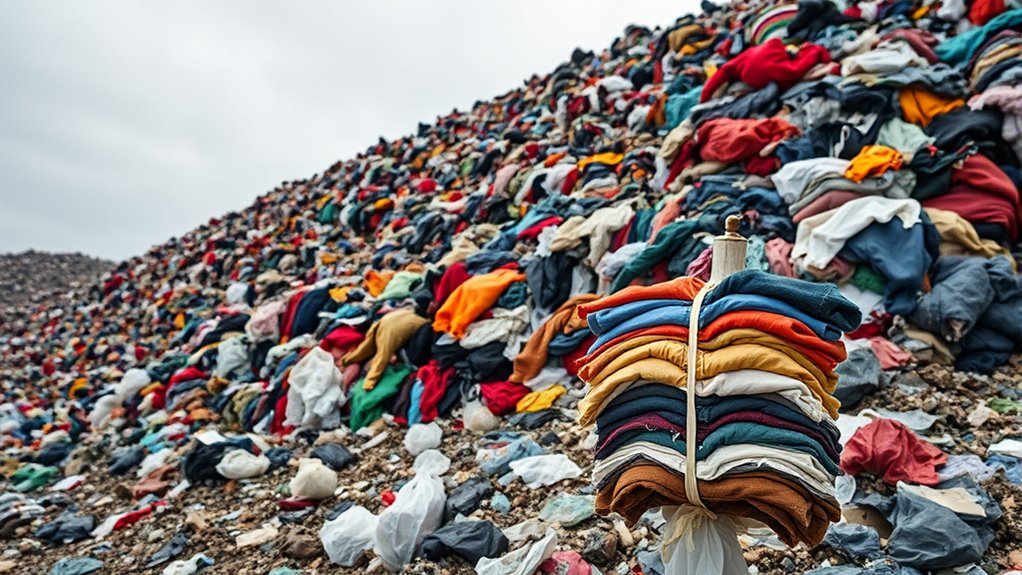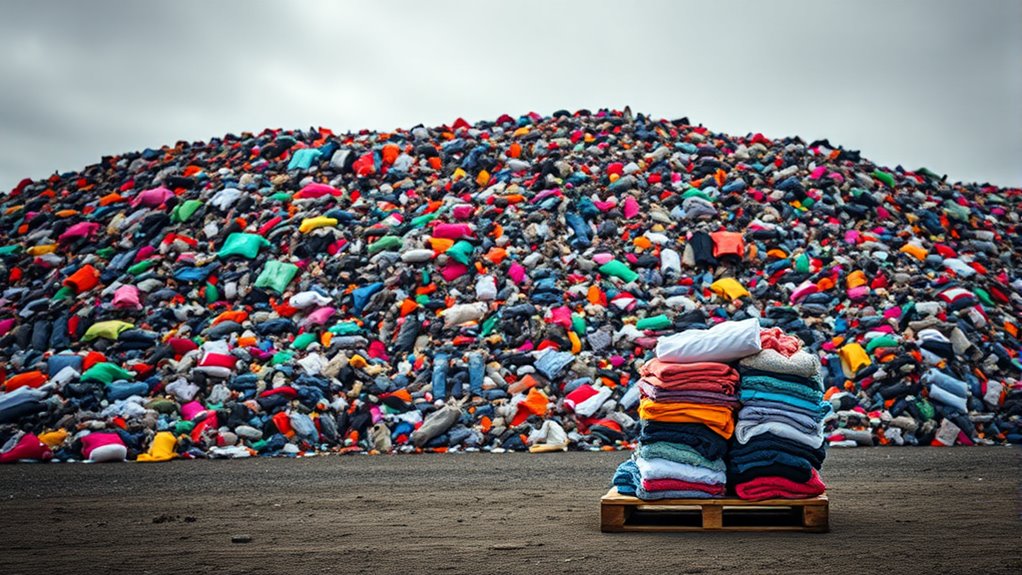Fast fashion creates massive waste by rapidly overproducing trendy clothes, which often end up in landfills or polluting the environment for decades. Synthetic fibers release microplastics, and chemical dyes cause pollution, harming ecosystems. By supporting ethical brands, you can choose longer-lasting, sustainable pieces made with eco-friendly materials, reducing waste and environmental impact. If you want to discover how your choices can make a difference, there’s more to uncover about sustainable fashion’s true benefits.
Key Takeaways
- Fast fashion produces massive surplus clothing that often ends up in landfills, taking decades to decompose and polluting the environment.
- Synthetic fibers from fast fashion release microplastics during decomposition, contaminating oceans and harming wildlife.
- Fast fashion’s quick turnover and low-quality materials lead to short clothing lifespans, increasing waste and environmental impact.
- Consumers’ disposal habits contribute significantly to textile waste, supporting the cycle of overproduction and environmental degradation.
- Ethical brands prioritize sustainability, produce durable clothing, and maintain transparent practices, reducing waste and ecological harm.

Have you ever wondered what happens to all those cheap, trendy clothes after you toss them out? The truth is, they often end up contributing to a massive issue known as clothing overproduction. Fast fashion brands churn out new styles at lightning speed to keep up with ever-changing trends, leading to a surplus of garments that no one truly needs. This relentless cycle results in a flood of clothing entering the market, much of which gets discarded before even being worn extensively. As a consumer, you might think you’re just making a quick shopping choice, but you’re part of a larger system that produces more clothing than can be reasonably consumed. This overproduction fuels a cycle where tons of textiles are manufactured, many of which will never find a rightful owner or even be worn once.
When you throw out these clothes, they don’t just vanish. Instead, they often end up in landfills, where they can take decades to degrade. The disposal environmental impact of fast fashion is staggering. Synthetic fibers, like polyester, don’t break down easily, releasing microplastics into the soil and water during decomposition. Natural fibers, while biodegradable, still contribute to pollution when they’re treated with dyes and chemical finishes. Landfills become overflowing with discarded textiles, and the methane released as organic materials decay adds to greenhouse gases, exacerbating climate change. Additionally, the energy used to produce and transport these garments adds to their environmental footprint, making fast fashion a leading contributor to environmental degradation. Furthermore, fast fashion waste often contains non-biodegradable synthetic materials that persist in the environment for centuries. Every time you toss out a cheaply made t-shirt or pair of jeans, you’re fueling this destructive cycle, often without realizing the long-term impact.
In contrast, ethical brands approach the problem differently. They prioritize sustainable practices, such as using eco-friendly materials, minimizing waste, and producing in small quantities. These brands focus on quality over quantity, encouraging consumers to invest in pieces that last longer and are made with less environmental harm. Ethical brands often use transparent supply chains, so you know where your clothing comes from and how it’s made. By choosing these brands, you help reduce clothing overproduction and lessen the disposal environmental impact. Instead of contributing to the endless cycle of fast fashion waste, you support a more sustainable fashion industry that values the planet and its people. Making conscious choices about what you buy and where you buy it from can make a real difference. It’s not just about your wardrobe—it’s about the future of our environment.
Frequently Asked Questions
How Does Fast Fashion Impact Microplastic Pollution?
Fast fashion markedly impacts microplastic pollution by increasing fiber pollution and microplastic shedding. When you buy fast fashion items, you contribute to the release of tiny synthetic fibers during washing, which then enter water systems. These microplastics harm marine life and contaminate ecosystems. Choosing sustainable brands helps reduce fiber pollution and microplastic shedding, making your fashion choices more eco-friendly and protecting our oceans from this growing pollution problem.
What Are the Long-Term Environmental Effects of Textile Waste?
Picture mountains of textile waste, slowly breaking down and seeping into the earth. Long-term, this landfill impact releases harmful chemicals, polluting soil and water. Unsustainable practices like non-eco-friendly dyeing worsen these effects, making landfills toxic. Over time, this disrupts ecosystems, harms wildlife, and threatens human health. Choosing sustainable dyeing methods and mindful disposal can help reduce these long-lasting environmental damages, protecting our planet’s future.
How Can Consumers Identify Truly Ethical Fashion Brands?
To identify truly ethical fashion brands, you should look for transparency in their practices. Check if they prioritize sustainable sourcing of materials and hold recognized ethical certifications like Fair Trade or GOTS. These indicators show a genuine commitment to environmental and social responsibility. Avoid brands that lack clear information about their supply chain or use vague claims. By doing your research, you can support brands that align with your values.
Are There Government Regulations Addressing Fast Fashion Waste?
Think of government policies as the compass guiding waste management efforts. Currently, regulations on fast fashion waste are limited and vary widely across countries. Some governments are starting to implement policies to reduce textile waste, encourage recycling, and hold brands accountable. However, many areas still lack exhaustive rules. You can push for stronger regulation by supporting initiatives that promote responsible waste management and hold fast fashion brands accountable.
What Innovative Technologies Are Reducing Fashion Waste?
Innovative technologies are transforming fashion waste reduction by using sustainable materials and recycling innovations. You can now find brands that incorporate biodegradable fabrics and compostable fibers, reducing environmental impact. Recycling innovations allow you to turn old garments into new textiles, minimizing landfill waste. These advancements help you support eco-friendly fashion choices and encourage brands to develop more sustainable practices, making a positive difference for the planet.
Conclusion
So, next time you’re tempted by that cheap, trendy piece, remember it’s not just a purchase—it’s part of a bigger story. Fast fashion’s waste piles up like an endless mountain, but you hold the power to turn the tide. Choosing ethical brands isn’t just about making better clothes; it’s about rewriting the ending of this story. Will you be a reader who changes the narrative, or will you let it fade into oblivion? The choice is yours.









